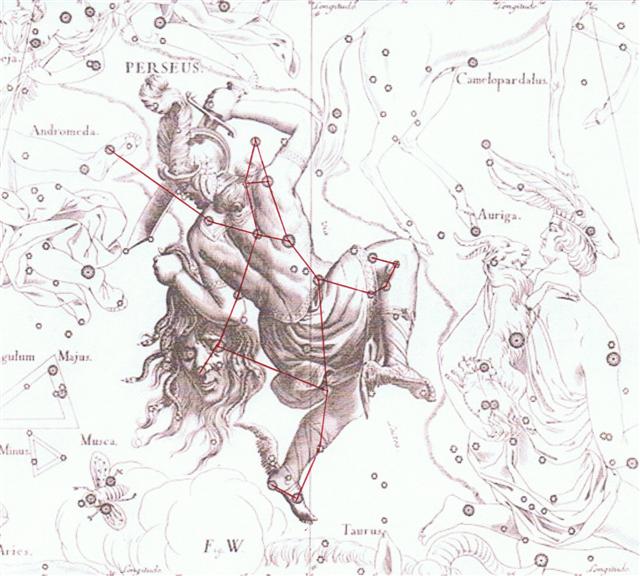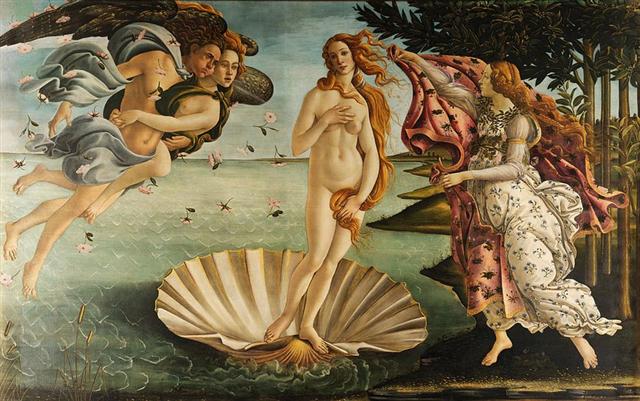Counting 8 days beyond Cb1-6 will bring us to
the Nose of the Sea Beast, to Menkar (α
Ceti). *44 = *36 + 8:

"In China α, γ, δ,
λ,
μ, ν, ο, ξ¹, and ξ², were Tseen
Kwan, Heaven's Round Granary." (Allen)
...
All was now ready for departure except that
there was no fire in the smithy. The ancestor
slipped into the workshop of the great Nummo,
who are Heaven's smiths, and stole a piece of
the sun in the form of live embers and white-hot
iron. He seized it by means of a 'robber's
stick' the crook of which ended in a slit, open
like a mouth.
He
dropped some of the embers, came back to pick
them up, and fled towards the granary; but his
agitation was such that he could no longer find
the entrances.

He
made the round of it several times before he
found the steps and climbed onto the flat roof,
where he hid the stolen goods in one of the
skins of the bellows, exclaiming: 'Gouyo!',
which is to say. 'Stolen!'.
The
word is still part of the language, and means
'granary'. It is a reminder that without the
fire of the smithy and the iron of hoes there
would be no crops to store
...
|
5 |
FEBRUARY 27 (*343) |
28 (424) |
MARCH 1 (60) |
|
APRIL 9 (*384) |
10 (465) |
11
(101) |
 |
 |
 |
|
Cb1-12 (404) |
Cb1-13 |
Cb1-14 |
|
manu rere - kua rere
ga manu - ki te ragi |
eaha te nuku erua |
koia kua huki |
|
April 29 |
30 (120 = *43 - 3 + 80) |
May 1 (11 * 11) |
|
*42
*225 |
DENEBOLA
(*43)
ZUBEN
ELAKRIBI (*226) |
MENKAR
= α Ceti
*227 |
|
October 29 |
30 (303) |
31 |
|
AUGUST 29 |
30 (242) |
31 |
|
OCTOBER 9 (*202) |
10 |
11
(284) |
| Huki
1. Pole attached to the
poop from which the fishing-net
is suspended: huki kupega. 2.
Digging stick. 3. To set
vertically, to stand (vt.). 4.
Huki á te mahina, said of the new
moon when both its horns have become
visible. Vanaga.
1. To post up, to
publish. 2. To cut the throat (uki).
Mq.: Small sticks which close up the
ridge of a house. Ha.: hui, the
small uniting sticks in a thatched
house. Churchill.
Standing upright.
Barthel. M. Spit for roasting. Te
Huki, a constellation. Makemson.
Hukihuki. 1.
Colic. 2. To transpierce, a pricking. 3.
To sink to the bottom. Churchill. |
Then a Tree was growing up
- perhaps to indicate Land had been reached.
|
Niu Palm
tree, coconut tree; hua niu,
coconut. Vanaga.
Coconut, palm, spinning top. P Pau.,
Ta.: niu,
coconut. Mgv.:
niu,
a top;
niu mea, coconut. Mq.:
niu,
coconut, a top. Churchill.
The fruit of
miro.
Buck. T. 1. Coconut palm. 2. Sign for
peace. Henry
The sense of top lies
in the fact that the bud end of a
coconut shell is used for spinning, both
in the sport of children and as a means
of applying to island life the practical
side of the doctrine of chances. Thus it
may be that in New Zealand, in latitudes
higher than are grateful to the coconut,
the divination sense has persisted even
to different implements whereby the
arbitrament of fate may be declared.
Churchill 2. |

|
MARCH 2 (61) |
3 |
4 (428 = 2 *
214) |
|
APRIL 12 (*387) |
13 (468) |
14 (104) |
 |
 |
 |
|
Cb1-15 |
Cb1-16 (408) |
Cb1-17 |
|
e niu tu |
ki te ariki - e ka hua
ra tona rima |
koia kua iri i ruga o
te rima - e o to vaha mea |
|
May 2 (121 = 11 * 11) |
3 |
4 |
|
ALGOL (*45)
ZUBEN
HAKRABIM (*228) |
BOTEIN (*46)
*229 |
*47
ZUBEN
ELSCHEMALI (*230) |
|
November 1 |
2 (306 = *46 + 260) |
3 |
|
SEPTEMBER 1 |
2 |
3 (246) |
|
OCTOBER 12 (285) |
13 (*206) |
14 |
|
MARCH 5 (64) |
6 (430) |
7 |
|
APRIL 15 (*390) |
16 (471) |
17 (107) |
 |
 |
 |
|
Cb1-18 (410) |
Cb1-19 |
Cb1-20 |
|
manu moe ra |
ki to mata |
e nuku mata |
|
May 5 (125) |
6 |
7 |
|
ZIBAL (*48)
*231 |
*49
*232 |
ALGENIB PERSEI
GIENAH
(*50)
*233 |
|
November 4
(308) |
5 |
6 |
|
SEPTEMBER 4 |
5 (248) |
6 |
|
OCTOBER 15 (*208) |
16 |
17 (290) |
|
MARCH 8 (432) |
9 |
10 (*354 = 12 * 29½) |
11 (70) |
|
APRIL
18 |
19 |
20 (*30) |
21 (111) |
 |
 |
 |
 |
|
Cb1-21 (413 = 14 * 29½) |
Cb1-22 |
Cb1-23 |
Cb1-24 |
|
hoea |
ko te rima |
kua oo ki te vai |
ma te ua |
|
May 8 |
9 |
10 (130 = *53 + 77) |
11 |
|
*51
NUSAKAN
= β
Cor. Bor. (*234) |
*52
GEMMA
SIRRAH (*235) |
ACRUX
(*53)
*236 =
8 * 29½ |
*54
COR
SERPENTIS (*237) |
|
November 7 |
8 |
9 |
10 (314) |
|
SEPTEMBER 7 (250) |
8 |
9 (*172) |
10 |
|
OCTOBER 18 (291) |
19 |
20 |
21 (*214) |
From niu 10 days passed before the Sun
reached Tau-ono:
|
MARCH 12 |
13 (72 = 172 - 100) |
3-14 (π) |
|
APRIL 22 (477) |
23 (*398) |
24 (114) |
 |
 |
 |
|
Cb2-1 |
Cb2-2 (418) |
Cb2-3 (27) |
|
Eaha te honu kua tupu |
i to maitaki - o te
hau tea |
te hono huki - maro |
|
May 12 |
13 (133) |
14 |
|
TAU-ONO (*55)
*238 |
ALCYONE (*56)
*239 |
MENKHIB
PORRIMA
(*57)
*240 |
|
November 11 |
12 (316 = *56 + 260) |
13 |
|
SEPTEMBER 11 |
12 (255 = 355 - 100) |
13 |
|
OCTOBER 22 (295) |
23 (*216) |
24 |
| Hono
Honohono to join,
to fit, to adjust, to unite, to patch,
joint. Hakahonohono a joining.
P Mgv.: hono,
to join or fit pieces of wood together,
to piece out a substance with another
piece of the same material. Ta.: hono,
to join, to unite. Churchill. |
There were 13 days from
May 1 (11 * 11) to heliacal Menkhib (ζ
Persei) and the midnight culmination of Porrima.
There were 13 nights from koia kua huki to te hono huki.
The
junction (te hono) was perhaps at glyph
420 (= 7 * 60 = 6 * 70 = 740 - 320), where 3
precessional days before the time of rongorongo
the 6 stones (Tau-ono) had been at the
Sun:
|
MARCH 15 |
16 (*360) |
17 |
18 (77) |
|
APRIL
25 (115) |
26 (*401) |
27 (482) |
28 (118 = 4 * 29½) |
 |
 |
 |
 |
|
Cb2-4 (420 =
14 * 30) |
Cb2-5 |
Cb2-6 (30) |
Cb2-7 |
|
te ua |
koia ra |
kua tuku ki to mata -
ki tona tukuga |
e kiore - henua - pa
rei |
|
May 15 (500) |
16 (136 = *59 + 77) |
17 |
18 |
|
ZAURAK (*58)
VRISCHIKA
|
*59
SCHEDIR (*242) |
COR
CAROLI
(*60)
ACRAB |
*61
LESATH |
|
November 14 |
15 |
16 (320) |
17 |
|
SEPTEMBER 14 |
15 |
16 |
17 (260) |
|
OCTOBER 25 (298) |
26 |
27 (300) |
28 (*221) |

In my list I have used the name
Menkhib for the star marking the left foot of
Perseus.
...
They walked in crowds when they arrived at
Tulan, and there was no fire. Only those
with Tohil had it: this was the tribe
whose god was first to generate fire. How it was
generated is not clear. Their fire was already
burning when Jaguar Quitze and Jaguar
Night first saw it: 'Alas! Fire has not yet
become ours. We'll die from the cold', they
said. And then Tohil spoke: 'Do not
grieve. You will have your own even when the
fire you're talking about has been lost',
Tohil told them.
'Aren't you a true god! Our sustenance and our
support! Our god!' they said when they gave
thanks for what Tohil had said.
'Very well, in truth, I am your god: so be it. I
am your lord: so be it,' the penitents and
sacrificers were told by Tohil. And this
was the warming of the tribes. They were pleased
by their fire.
After that a great downpour began, which cut
short the fire of the tribes. And hail fell
thickly on all the tribes, and their fires were
put out by the hail. Their fires didn't start up
again. So then Jaguar Quitze and
Jaguar Night asked for their fire again:
'Tohil, we'll be finished off by the cold',
they told Tohil. 'Well, do not grive',
said Tohil. Then he started a fire. He
pivoted inside his sandal
...




















